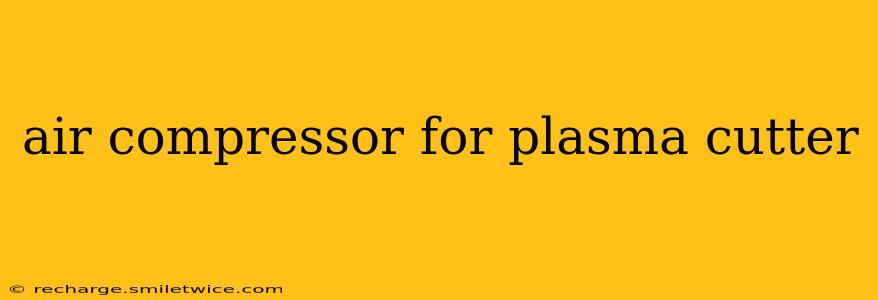Choosing the right air compressor for your plasma cutter is crucial for optimal performance, safety, and longevity of your equipment. A poorly matched compressor can lead to inconsistent cuts, premature wear, and even damage to your plasma cutter. This guide will help you navigate the complexities of selecting the ideal air compressor for your needs.
What CFM and Tank Size Do I Need for My Plasma Cutter?
This is the most frequently asked question, and the answer depends entirely on your plasma cutter's specifications. Always consult your plasma cutter's manual. It will clearly state the required CFM (cubic feet per minute) at a specific PSI (pounds per square inch). This information is non-negotiable. Using a compressor with insufficient CFM will lead to inconsistent cutting, reduced power, and potential damage to your plasma cutter. The tank size is less critical, but a larger tank offers a buffer, preventing the compressor from constantly cycling on and off, extending its lifespan and providing a more consistent air supply. A larger tank also means fewer interruptions during longer cutting jobs.
How Many SCFM Does a Plasma Cutter Need?
SCFM (standard cubic feet per minute) is a measure of airflow at standard temperature and pressure. While your plasma cutter's manual might specify CFM, understanding SCFM is important because it's the industry standard for compressor output. Many compressors list both CFM and SCFM. Prioritize the SCFM rating, ensuring it meets or exceeds your plasma cutter's requirements. Again, check your manual for precise requirements.
What PSI Air Compressor Do I Need for a Plasma Cutter?
The PSI requirement is generally less critical than CFM, but it's still important to ensure your compressor can reach the minimum PSI specified by your plasma cutter's manual. Most plasma cutters operate efficiently within a PSI range of 80-100 PSI, but you must verify this for your specific model. While having a compressor with a higher PSI capacity won't hurt, it's not as significant a factor as CFM. Focus on meeting the CFM requirement first.
Can I Use a Small Air Compressor for a Plasma Cutter?
Possibly, but it's highly discouraged. A small air compressor often lacks the CFM capacity needed to provide a consistent air supply to the plasma cutter, leading to inconsistent cuts, overheating, and potential damage to the machine. While you might get away with it for very short, light-duty applications, it's a risky proposition. Investing in an appropriately sized compressor is far more cost-effective in the long run.
Best Air Compressor for Plasma Cutter: What to Look For
Selecting the "best" air compressor depends on your specific needs and the type of plasma cutting you perform. Consider these factors:
- CFM and SCFM Requirements: This is paramount, directly impacting cutting quality and machine longevity.
- Duty Cycle: This indicates the percentage of time the compressor can run before overheating. A higher duty cycle (e.g., 50% or higher) is preferable for longer cutting jobs.
- Tank Size: A larger tank provides a more consistent air supply and reduces the frequency of compressor cycling.
- Horsepower (HP): This correlates with the compressor's power and ability to deliver the required CFM.
- Noise Level: Consider the working environment. Noisier compressors may require additional soundproofing measures.
- Portability: For mobile applications, a portable compressor is essential.
Conclusion: Invest in the Right Equipment
Choosing the right air compressor for your plasma cutter is a crucial decision that impacts performance, safety, and the overall lifespan of your equipment. Don't skimp on this investment. By meticulously following the guidelines outlined above and carefully considering your specific cutting needs, you can ensure you select a compressor that perfectly complements your plasma cutter, leading to superior results and a more efficient workflow. Remember to always prioritize the CFM and SCFM requirements specified in your plasma cutter's manual.
